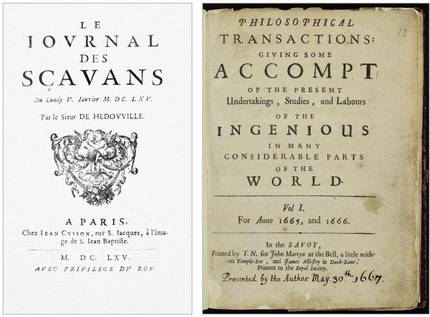Scientific publication system and predatory journals
It is a complex international system of scientific publications and a round business for many publishers. The subscription prices for prestigious journals are disproportionate and predatory journals can be found everywhere waiting for victims who need to be published. How have scientific journals become a unique business?
XVII. The first scientific journals born in the nineteenth century have been the basis of the science communication system. XX. In the 20th century the number of scientific journals has grown steadily, and today thousands upon thousands of scientific journals are published worldwide. However, the global publishing market is in the hands of five publishers. In addition to these large publishers, the rest are small commercial publishers or small publishers, universities and scientific societies that publish small journals.
Internet creation radically changed the publishing system of science. Before creating the digital world, paper scientific journals could only be obtained by subscription, in most cases. XX. In the last decades of the 20th century, subscription prices continued to rise due to the serial crisis (Guédon 2017). This crisis was, together with the development of new technologies, one of the causes of the emergence of open access. The free and free availability, through various manifestations and manifestations, of the results of publicly funded research has had a direct impact on the entire science communication system.
The evolution of open access, however, is far from the idyllic vision of the first defenders and promoters.
Greenway and gold
There are two main and complementary ways for the introduction of scientific articles in open: one of them called the greenway, which consists of the reception of articles and scientific works in digital deposits or archives; the other, called the golden way, is based on its publication in open access scientific journals.
The first promoters of open access supported the greenway (Harnad 2004) and ArXiv, founded in 1991 by Alan Ginsparg, is the main exponent and pioneer of this path. This is a deposit of mathematical and physical preprints, in which researchers upload works that have not yet been published in journals. Several versions authorized by journals (preprints, postprints and publisher version) can be uploaded to current deposits. However, the greenway has not been so successful in other areas and, often, due to ignorance or lack of funding entities that do not force it, this path of open access is not used. There is a widespread habit of using academic social networks rather than deposits, such as ResearchGate and Academia.edu. Social media does not always comply with editorial copyright policies, and should be used cautiously.
Therefore, the golden path is identified with open access, that is, its publication in scientific journals that allow open access. Open access journals respond to different business models with different characteristics in each discipline. In human and social sciences it is customary for university publications, scientific societies and public bodies to publish journals. In these areas, as they are marginal benefits, open access was immediately established, which in addition to being free for reading and reuse, usually does not entail any cost for publication.
In scientific and health journals the situation is different. Since Springer created the Open Choice option in 2004, it is common to have to pay to publish it in prestigious and prestigious international scientific journals. These fees are called APC or Article Processing Charges. For example, the BMJ group's journals require £3000 AGPs. These fees are paid, in most cases, from research project budgets, but if researchers do not have such sources of income, they must be paid out of pocket.
If there are incidents in this business model, there are magazines that publish all the works in open charge fees and others that do not. Another business model is that of subscription journals that allow the opening of articles in case of payment by APC. The latter are called hybrid journals and have been strongly criticized, since it is understood that the published in them is paid twice: the subscription itself and the APC. Some say it is paid three times, since research work is normally paid with public money.
The editorial system of current science is in the hands of major publishers, a clear oligopoly case. Five are the international publishers in possession of the market: Reed-Elsevier, Springer, Wiley-Blackwell, Taylor & Francis and Sage. Universities and national negotiating groups negotiate annual subscription costs for journals with publishers. In the last year there have been several subscriptions that have been cancelled, since they have not been able to reach a satisfactory agreement with the publishers, being significant the case of Elsevier.
10% of US scientific results correspond to the University of California, which paid 10 million dollars in subscriptions to Elsevier in 2018 (McKenzie 2018). In 2019 he cancelled his subscriptions to Elsevier for open access issues (UC and Elsevier, 2019). The same decision has been made in Norway, as Elsevier does not meet the open access requirements established by Norway (“Norwegian research institutions have decided not to renew their agreement with Elsevier”, 2019). In the case of Norway, they have reached an agreement for reading and publishing. These agreements are called read and publish deal. In addition to the 2,800 journals published by Elsevier, 90% of what Norwegian researchers publish in Elsevier journals can be read for free (Else 2019).
Publish or Perish
These are not the only cases, since in Germany, Sweden and Hungary national licensing processes have been suspended with Elsevier and the Dutch publisher has cut access to journals in several places (Else 2019), with the exception of the University of California.

The current research evaluation system encourages researchers to publish their papers, known as Publish or Perish. If you want to advance your career you have to publish the results of your research. However, not all journals have the same value in this system, since in the international databases Web of Science and Scopus indexed journals are prioritized, and if this is not achieved, these are international journals. Science and technology journals written in English are the most common in databases. However, regardless of whether they are international or not, the quality assurance of scientific journals is a peer review system, a work that researchers do free of charge.
Thus, among researchers there is also enormous competition in publishing efforts. Taking advantage of these needs of researchers, the so-called predatory journals have appeared. These journals have very aggressive activities, they contact the authors to request publication papers and the deadlines from receiving the articles until they are published are very short. APC must be paid, but they are much lower than prestigious journals. If in a world-famous magazine you have to pay taxes higher than € 2,000, in predatory journals sometimes cost less than € 100, a few hundred times. They mainly turn to poor countries and researchers with few sources of funding.
In recent years, predatory journals have been growing, driven by Publish or Perisha. Some of its characteristics are very outstanding: they publish articles immediately after their reception, often without any change or adaptation, with fictitious peer reviews, often with the word “International” in the title or similar to the title of a magazine known in the matter; editorial committees are not transparent or the names are of experts of recognized prestige; and of course, they always charge APC s.
Predator identification
How can a researcher choose which journal suits him?
Different tools, products and services can be accessed. Librarian Jeffrey Beall published a list of predatory journals entitled Beall List. Beall has written several papers on predatory journals (2015) (2013) (2018). In 2017, due to the influence of different lobbyists, Beall removed the listing from the website, but it is possible to consult an updated copy of it (Beall’s List of Predatory Journals and Publishers 2019).
There are currently several tools to identify quality open access journals, but the important and necessary is the DOAJ directory of open access journals, created at Lund University in Sweden. For a journal to appear on the list it is necessary to have a peer review process, since in 2014 the inclusion criteria were hardened. It offers a lot of information on business models and publishers, including APC.
Since DOAJ indexing is considered a quality criterion, there are journals that indicate that they are included in it, although in reality it is not. They have created lists that report these journals (“Some journals say they are indexed in DOAJ but they are not”, 2019). As an example, the title of a journal is: American Journal of Engineering Research is indexed in DOAJ on the web. Some of the information and data collected in the journal indicate that the journal is totally suspicious: although in the title is American, the addresses are from India; the APC are 60$, but they prioritize the rupis in the conversion chart of the web; although it is an engineering journal, in the editorial committee can be found members of the field of health and physics. However, not all predatory journals are easily identifiable.
We can also find products specialized in certain disciplines such as Open Access Journal Whitelist, created by the Berlin Institute of Health for the area of biomedicine.
Another tool that can be used in journal selection and evaluation is the ThinkCheckSubmit website. Here you can find a list of criteria driven by a group of agents working around academic communication, translated into several languages.
White and black lists that can be purchased on payment have also been published. Cabell’s Whitelist/Blacklist is an example of these products. The list of predatory journals has also been described as a predator.
Open access has revolutionized the science communication system, but the characteristics of quality journals have been maintained. One of the essential requirements is the peer review process and quality scientific journals, whether open access or not, must meet this requirement.
If you don't find a suitable open access journal or can't afford APC, you can use thematic and institutional deposits as an alternative. Moreover, in addition to the tools and resources listed in this article, you will always be available to librarians to help you.






